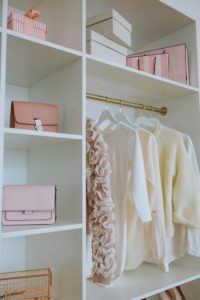 CURATING A CAPSULE WARDROBE: FELDENKRAIS® STYLE
CURATING A CAPSULE WARDROBE: FELDENKRAIS® STYLE
Those of you interested in either sustainable fashion or decluttering may have heard or read about a “capsule wardrobe”. A capsule wardrobe is made up of a limited selection of pieces that you feel good while wearing and can be worn in different combinations so that several outfits can be generated out of a relatively small number of items that, as Marie Kondo would say, “spark joy”. Adieu to crowded closets and a sense of overwhelm just figuring out what to wear.
So how can this idea be applied to the practice of the Feldenkrais Method®? In my view, the more direct analogy, especially for newer practitioners, is in Functional Integration®. My experience as a mentor to trainees and new practitioners suggests that it is common for them to feel overwhelmed by all the “lessons” they were exposed to. Somehow, in order to be a “quality practitioner” one has to remember them and be comfortable performing all of the hands-on movements embedded in them. With over 18 years of practice behind me, I can definitively say that this has not been my experience.
Though only relatively recently did the metaphor of the capsule wardrobe come to me, from the start I recall assessing what I wanted to focus on with my client that day.
Rather than trying to recall and recreate a lesson that I had experienced, I would ponder what FI skills I felt both would be useful for the client and be ones that I felt good doing. From there the lesson would emerge. This is the essence of a “capsule wardrobe” approach to giving Functional Integration lessons.
I recall my primary trainer Elizabeth Beringer saying that one thing she loved about Feldenkrais® was how generative it is. What could be a more generative way to give lessons? Of course, all good lessons, even if staying very close to a template, are adapted to the moment. That being said, I believe that having interchangeable bits of “technique” that you feel confident with is an even more creative, and in my experience, more effective approach.
Applying the “capsule wardrobe” metaphor to Awareness through Movement ® is somewhat different. Although seasoned practitioners can and do create their own ATMs, this is not something I would recommend to newer practitioners teaching groups. So how can this idea of a small selection of “items” you feel really good about work here?
For teaching groups, I recommend newer teachers start with materials designed for the public such as those produced by Feldenkrais Resources just as an example based on my own experience. The Relaxercise series is nice because it explores so many functions in one series. Work with these lessons with the idea of what Larry Goldfarb would call finding and understanding the “red thread”. What are the key steps and why are they presented in the order that they are? There is no need to be “perfect” at this. No one can absolutely know the intention of another. Still this is a good start.
After working through some basic lessons, pick those that most resonant for your teaching. As I will address more later, this can change over time.
Another way to use ATM “capsule style” is to find the small pieces of movement that explore the themes of your FIs and use them as “homework”. My own experience is that though not many private clients will do several full ATMs in a week, many will do a couple of minutes consistently.
PROFESSIONAL DEVELOPMENT
One good argument against this “capsule” concept is that over time it can be limiting. Who wants to look in the closet and see the same clothes for ten years! My primary intention in presenting the “capsule concept” is to give newer practitioners tools to be confident and effective early on without that sense of overwhelm I have heard expressed so many times.
So, what are the next steps? Continuing with the metaphor, just imagine that this approach led you to a thriving practice and now you live somewhere with bigger closets so you can, at your own pace, add more “pieces of FI technique” or ATM lessons. Alternatively, you can choose to “declutter” some of what you have, making way for new items.
There are several ways to do this, all good, and including …
- revisiting your training materials on your own or with classmates in person or online
- joining any sort of study group
- taking advanced training
- working with a mentor
What I would like the take away to be here, is that having a solid capsule helps remove both a sense of overwhelm and the urgency around getting more and more training in order to feel like you can confidently and effectively practice.

Lovely article. I am feeling overwhelmed just now!